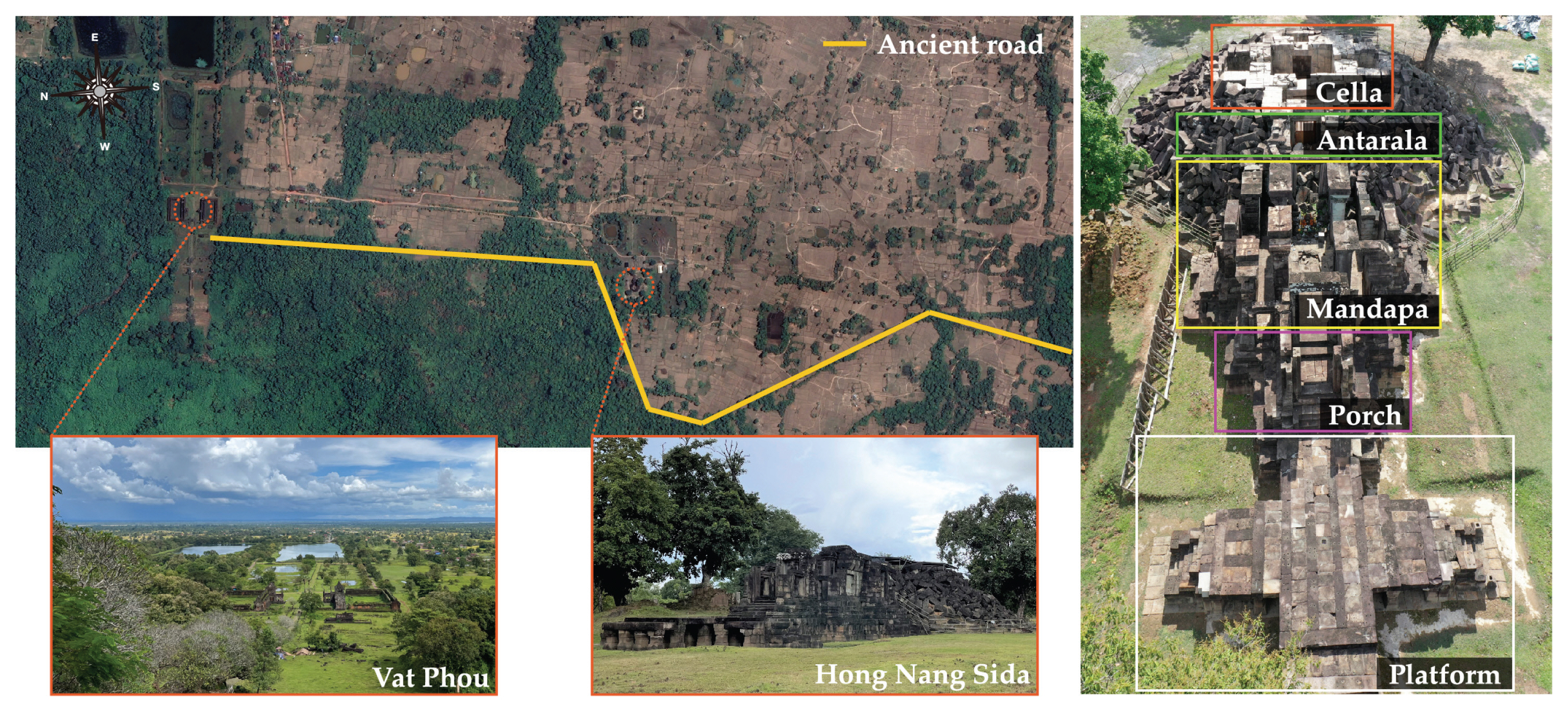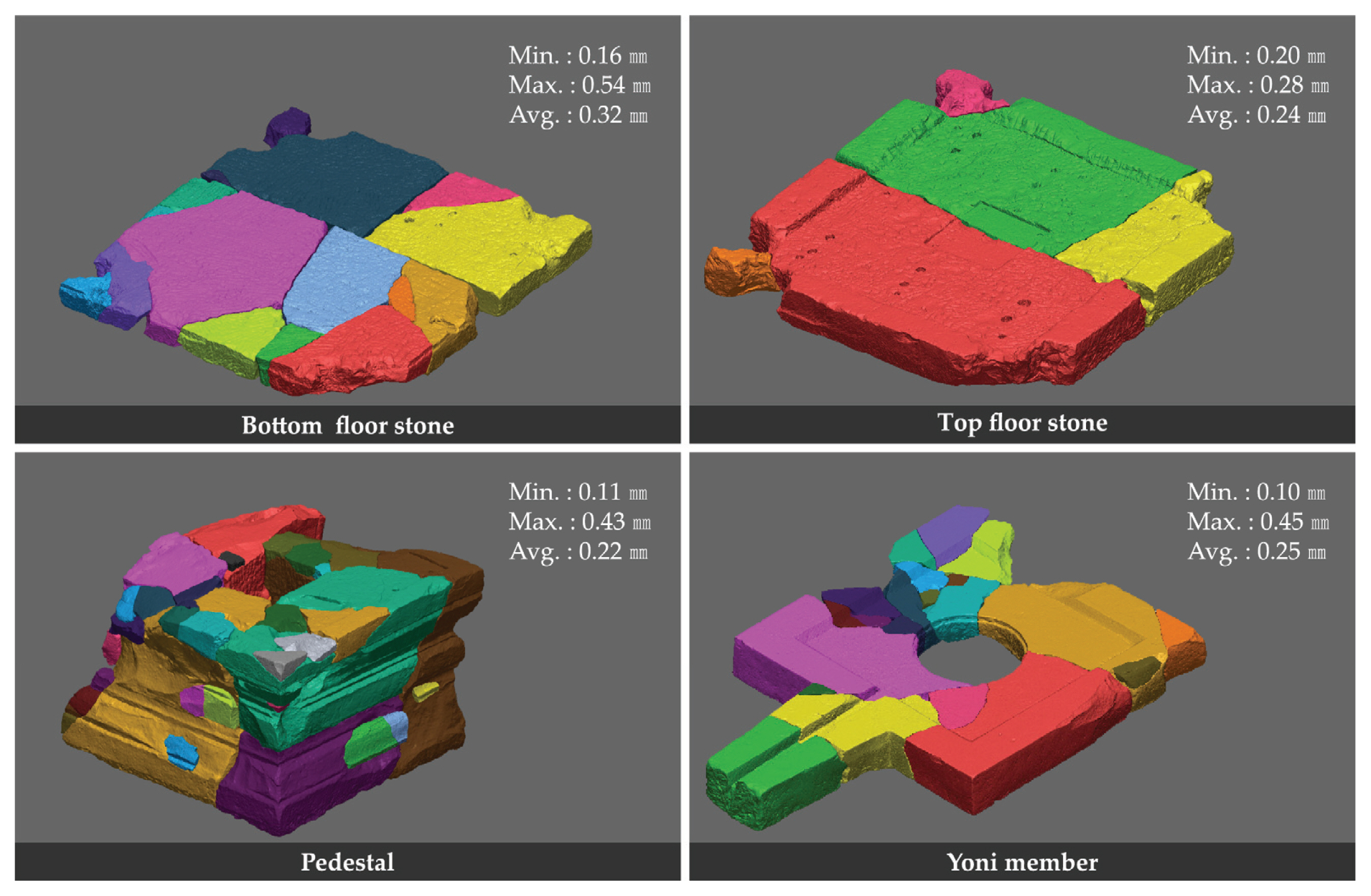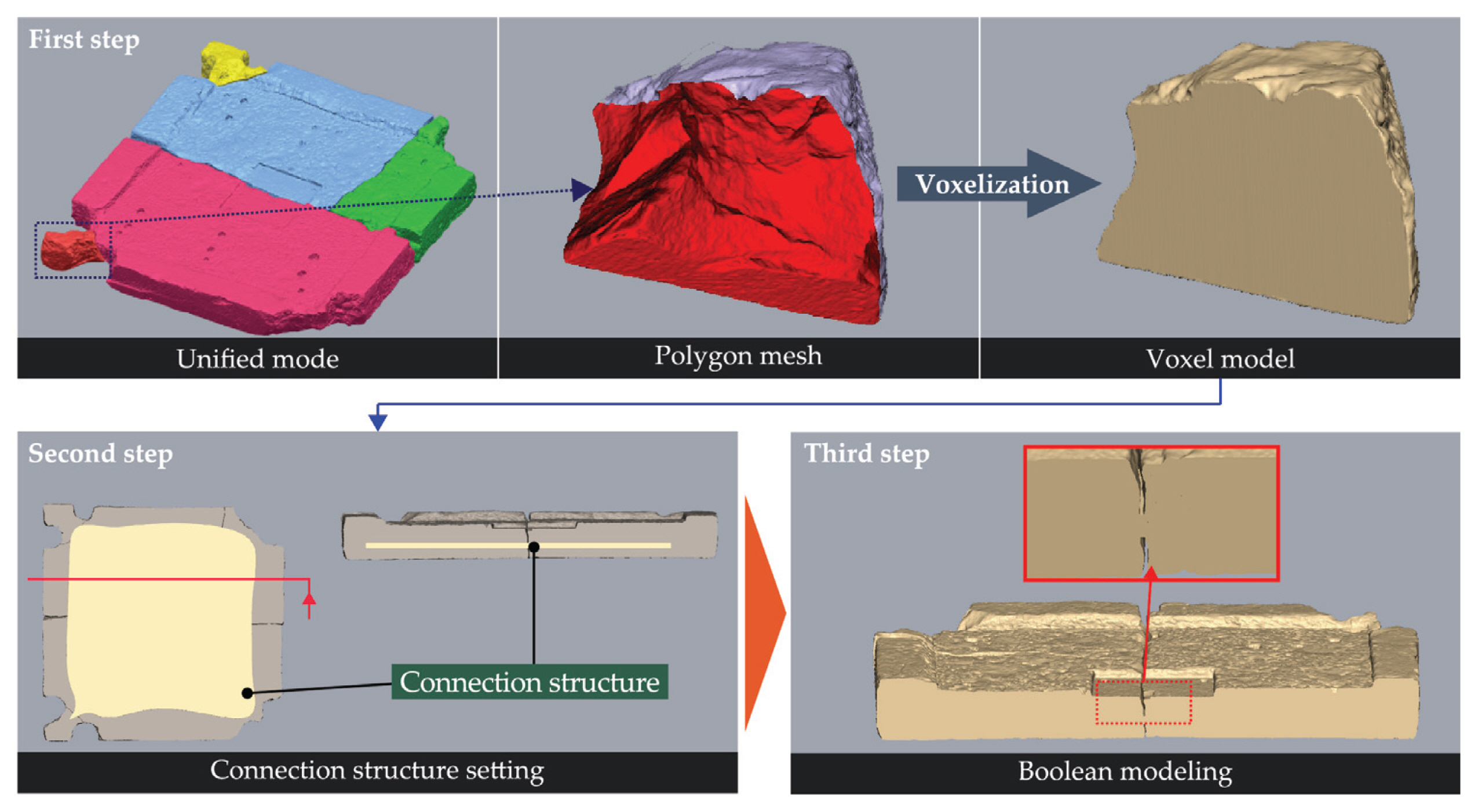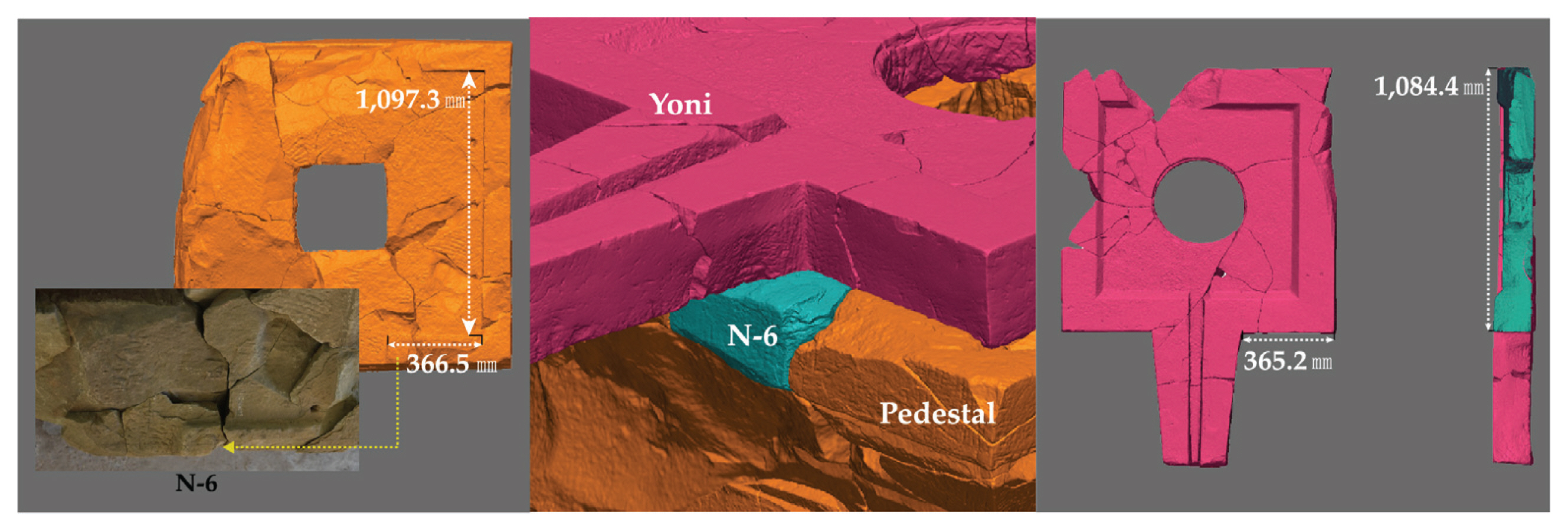Study on the Digital Reassembly of Yoni Monument Excavated from Cella of Hong Nang Sida, Lao PDR
Article information
Abstract
During the dismantling of the cella of the Hong Nang Sida temple in Laos, 100 highly significant Yoni-monument members were recovered as fragmented individual stones. To restore the Hong Nang Sida temple to its former glory, it is necessary to restore the fragmented Yoni-monument members to their original positions. However, the high weight and low mobility of the stones make it difficult to physically reassemble the story members. Therefore, this study utilized three-dimensional (3D) scanning, modeling, and printing technologies to digitally reassemble the Yoni monument. To achieve this goal, optimization modeling was performed to connect the three-dimensional (3D) scanning data of individual fragmented stones, after which each story member was reduced to a 1/5 of its original size and printed by sand printing to evaluate the feasibility of physical assembly. Finally, 3D scans of the Yoni monument assembled using the sand-printing outputs were taken, and all the story members were virtually aligned based on the scan data to complete the digital reassembly. We believe that the results of this study will improve the feasibility and completeness of the physical reassembly by allowing for a full preliminary examination of stone blocks, which would otherwise be difficult to achieve because of the risk of secondary damage or weight limitation. In particular, it is possible to objectively and visually illustrate the geometric relationship between the members of each story, which can be extended to similar stone-based cultural heritage sites. To broaden the utility of the digital-reassembly model, it must be evolved into a historic building information model that links the unstructured data, including documents, photos, and images, obtained throughout the process life cycle.
1. INTRODUCTION
UNESCO World Heritage Sites are global assets and a vital means of passing on our history to future generations; they are also a part of our living and breathing spaces. South Korea began providing conservation-technology support to world heritage sites overseas in 2000, starting with the conservation of ancient tombs and murals of the Goguryeo Dynasty in North Korea. In particular, since 2012, South Korea have expanded our trust fund project for the protection of world heritage sites to the Asia-Pacific region, with representative countries being Laos, Cambodia, Myanmar, and Bangladesh. In particular, the project for the conservation and restoration of the Hong Nang Sida temple in Laos is the first public-development-assistance project carried out by the cultural heritage field in South Korea. The Cultural Heritage Administration promoted the project to spread South Korea’s conservation-management technology and elevate the nation’s prestige through a cooperation program for the conservation of cultural heritage sites in underdeveloped countries.
During the dismantling process of the collapsed members inside the cella of Hong Nang Sida from 2021 to 2022, the Yoni-monument members, the main deities of the temple, were collected. The collected Yoni-monument members were not excavated as a complete unit, making it difficult to determine their original locations. Moreover, the individual stones were fragmented, making their restoration difficult. Therefore, restoring the historical value of Hong Nang Sida requires the identification of the original positions of the fragmented stones and the physical reassembly of the individual fragments.
Reassembling fragmented artifacts can be accomplished by exploiting a variety of morphological similarities, including boundary curves, decorative patterns, and painted textures. However, repeated physical reassembly can be time-consuming and damaging (secondary damage). In addition, it is difficult to physically reassemble parts that are too fragmented or heavy to mobilize.
Fortunately, advances in digital technologies, such as computer graphics and three-dimensional (3D) scanning, are providing new methods for reassembling deteriorated cultural heritage sites. Three-dimensional scanning technology, which builds a digital model of fragments, provides precise geometry data for improving the reliability of the physical reassembly. Digital reassembly, which reconstructs fragmented shapes into their original form, is independent of the constraints of time and space and can overcome the limitations of manual work. It is also becoming increasingly important because of its many benefits, including virtual representation and gap repair.
Moreover, digital reassembly using 3D scanning technology is being combined with 3D printing technology and used in a variety of applications. Three-dimensional printing enables the obtention of a real structure of an object by producing the acquired geometry data as a mockup or scale model. In addition, using printouts, the secondary damage that may occur during physical reassembly can be identified and prevented in advance.
Accordingly, digital-reassembly research overcomes the limitations of physical reassembly and enables a variety of simulations in a virtual environment. Therefore, in this study, 3D scanning and printing-based digital reassembly were performed to reconstruct the original Yoni-monument members excavated from the Hong Nang Sida cella.
2. MATERIAL AND METHODS
2.1. Material
Hong Nang Sida in Laos is one of the temples included in the “Vat Phou and Associated Ancient Settlements within the Champasak Cultural Landscape,” which was inscribed as a UNESCO World Heritage Site in 2001. The name means “Temple of the Sida Princess” or “The room of Princess Sida,” and the structure is believed to be a royal temple built by the Angkorian dynasty. Hong Nang Sida is highly regarded for its historical and cultural value, as it is the starting point of the ancient road that leads to the ruins of Angkor Wat in Cambodia from the temple of Vat Phu (Figure 1). Facing east, there is a garam-style main hall consisting of a platform, porch, mandapa, antarala, and cella. There is no written record of the exact purpose of the Hong Nang Sida temple or how it was utilized. However, the architectural designs and precision are comparable to the temple architectural designs of the capital city of Angkor at the time.
Therefore, the Korea Cultural Heritage Foundation held a groundbreaking ceremony in 2013, and after three years of preliminary research and two years of establishing a maintenance environment, the temple was dismantled and is being restored. From 2017 to 2018, 675 stones were recovered, with the discovery of previously unknown statues and guardian deities. In particular, during the dismantling investigation in 2019, a gilt bronze religious relic called “Yoni” was discovered, and it has been receiving attention from related experts and the Lao people. Since 2021, the dismantling of the cella has been ongoing, and the excavated and dismantled stones have been transferred to the Stone Hospital in the field, where they are being numbered and stored. Notably, the dismantling process is ongoing, as there are still collapsed members on the outside.
In 2021 and the first half of 2022, the dismantling of the collapsed cella unearthed floor stones, a pedestal, the fragmented stones of the Yoni monument, deposit stones (which may have been employed to dedicate gold or jewelry), and pipes that may have been used to connect holy water from the Yoni to the drainage system. The Yoni-monument members were located quite a distance away from the central shaft, which is believed to be their original location, and the floor stones are still standing, suggesting that they were either artificially moved or the original shaft was damaged by looting. These members are being transported to the Stone Hospital. The deposit stones and pipes were simply cleaned, and the fragmented stones of the pedestal were cleaned and bonded with epoxy resin (L-30) and metal reinforcement (titanium rods). In addition, the fragmented bottom and top floor stones as well as the Yoni were temporarily bonded after washing (Figure 2). To some extent, the shapes of the members in each story have been restored as a single object through conservation treatment; however, their structural stability is low. Additionally, the weight of members in each story is significant, which would cause secondary damage if physical assembly is attempted. Therefore, it is necessary to utilize digital technology to identify the suitability of members in each story for stable assembly.
2.2. Study Methods
The Yoni-monument members in the cella were excavated as fragments of different sizes that did not maintain their original shapes. The precision of the joint surface is very important because the individual parts must all be utilized for reassembly. Therefore, 3D scanning was performed using a handheld medium-precision scanner. The scanner that uses VCSEL structured light and color camera (2.3 MP) has an point accuracy of 0.1 mm and a maximum resolution of 0.2 mm. The data were processed by filtering, registering, merging, and RGB-texture mapping. Accordingly, 100 3D-shaped objects were constructed, including 16 for the bottom floor stones, 5 for the top floor stones, 56 for the pedestal, 21 for the Yoni fragments, 1 for the deposit stone, and 1 for the pipes (Figure 3).
The 3D scanning models of the stone fragments were aligned in the virtual environment based on the scan data of the physically joined members in each story. In addition, the assembly of members in each story was based on the geometry analysis of the joint surface to determine suitability. However, the digital 3D model could not consider physical collisions, making it difficult to set the exact assembly position. Therefore, members in each story were reduced to 1/5 of their original size and printed by a sand 3D printer with binder jetting. The printouts were checked for physical-assembly suitability. The material employed for the output was sand, with a size of approximately 140 μm, and the layer thickness was set to 0.28 mm.
3. RESULTS
3.1. Virtual Alignment of the Fragmented Stones
The fragmented stones at the bottom and top parts of the floor stone, Yoni, and pedestal were applied for physical temporary joining and conservation treatment after the 3D scanning was completed. Therefore, in this study, digital assembly was performed by the virtual alignment of fragmented individual stones that had been temporarily joined based on a 3D model in each story. The accuracy of the assembly was determined by calculating the root-mean-square (RMS) deviation of the virtual alignment results (Figure 4).
First, the virtual alignment of the 16 bottom floor stones showed an overall RMS deviation of 0.16 to a maximum of 0.54 mm, with an average RMS of 0.32 mm. In addition, five top floor stones had an almost similar RMS deviation of 0.20–0.28, and the average RMS was determined to be 0.20 mm. The virtual alignment of the pedestal consisting of 50 stones showed a minimum RMS deviation of 0.11 and a maximum of 0.43 mm, with an average RMS of 0.22 mm. Finally, the RMS of the 21 Yoni stones ranged from 0.10 to 0.45 mm, with an average RMS of 0.25 mm (Figure 5). The RMS variation was attributed to the fine changes in the surface condition that occurred after the individual stones were repaired and the subsequent dismantling and contaminant cleaning of the repaired members.
3.2. Digital Reassembly
The Yoni excavated from the cella were divided into bottom and top floor stones, the deposit stone, the pedestal, and the Yoni-monument members. In this study, optimized modeling and 3D printing techniques were applied to digitally reassemble members in each story, which is difficult to achieve physically because of their weight. First, optimization modeling was performed to connect the 3D scanning data of the fragmented individual members. This is because it is difficult to analyze the assembly based on each story and perform 3D printing when each fragmented stone is represented as separate data in a single model.
To transform a 3D scanning model of a fragmented stone into a unified model, it is necessary to create connections through the individual stones. Therefore, the polygonal mesh was voxelized and converted into a volume model. The voxel resolution was set to 0.3 mm to account for the precision and printing of the 3D model. Thereafter, a connection structure within 10 mm, through which the entire individual member could pass on the reference plane, was designed and completed as a single closed model through the Boolean process (Figure 6).
These completed members in each story were printed with a binder-jetting-type sand 3D printer. In this method, the raw material, micrometer-scale silica sand, was evenly stacked one layer at a time, and the target cross-sectional shape was achieved by spraying with a binder to harden the particles. Complex shapes can also be manufactured in one piece, and uncured sand acts as a natural support. Therefore, separate postprocessing is not required. As an advantage, sand printing and sandstone masonry use similar materials, and the high density of the materials allows them to reflect loads when reviewing assemblies. An additional reinforcement treatment was applied to improve the physical properties of the 3D printing output (Figure 7).
The digital reassembly was performed in a virtual environment, preceded by geometric analysis and validated by physical assembly using printed outputs. First, both the bottom and top floor stones did not exist in their original shapes, and the horizontal and vertical lengths were similar, making it difficult to clearly grasp the assembly structure. However, there were artificially manufactured features at the corners of the two floor stones. They were sampled at four points to compare dimensional differences, which varied depending on the condition state; however, the length differences were generally low, ranging from 0.3 to 6.4 mm. In addition, as a result of extracting and comparing the 6 mm cross-sectional line of each member, it was observed that the bottom and top floor stones, except for the damaged part, have a very high degree of shape conformity overall (Figure 8).
The assembly between the top floor stone and the deposit stone can be confirmed by the small joint remaining on the upper surface of the floor stone. By measuring the dimensions of the assembly, the joint of the top floor stone was determined to be 380.9 wide and 378.3 mm long, whereas the lower surface of the deposit stone was measured to be 371.6 wide and 370.4 mm long. The two members basically have a square shape. In particular, the deposit stone was approximately 10 mm smaller than the small joint of the top floor stone, which was considered to increase the ease of assembly (Figure 9).
To determine the assembly suitability of the top floor stone and the pedestal, the dimensions of the large joint of the top floor stone and the lower surface of the pedestal were measured. The top floor stone’s large joint was 1364.1 wide and 1384.2 mm long, whereas the lower end of the pedestal measured 1357.6 in width and 1383.5 mm in length. When comparing the width and length dimensions, the large joint groove was larger than the lower part of the pedestal, which is a factor that increases the assembly fit. When assembling with β-α ‘ or δ-α ‘ rather than α-α ‘, intuitively judged as the optimal direction through the sand-printing output, it can be observed that the assembly surface lengths do not match, resulting in separation and surface interference on the 3D shape data (Figure 10).
Finally, to infer the assembly structures of the pedestal and Yoni, the structure connected to the entrance of the Yoni on the upper part of the pedestal in “N-6” stone was considered, which promoted physical assembly. The dimensions of the location where the Yoni and the pedestal were assembled were measured, and the dimensions of the lower a point of the Yoni and the upper a point of the pedestal were 365.2 and 366.5 mm, respectively, and the dimensions of cross-section and pedestal of the Yoni were 1084.4 and 1097.3 mm, respectively. This proves that the assemblies of the two shapes match well in dimensions (Figure 11).
After completing the assembly suitability between the members of each story, the sand-printing model was directly assembled to reproduce the overall shape of the Yoni. The physical-assembly results were very consistent with the shape-analysis results conducted in advance. Furthermore, the reliability of the actual assembly of the Yoni-monument members was high. Therefore, the sand-printed outputs were employed to perform 3D scans of the physically assembled Yoni, enlarged five times, and aligned with the 3D models in each story to complete the digital reassembly (Figure 12). The size of the restored Yoni is 1.0 m wide, 2.0 m long, and 3.0 m high.
4. DISCUSSION
Accurate records are essential for restoring and organizing cultural heritage sites to their original shape. Actual survey is the primary means of documentation for the study and repair of cultural heritage sites. In the past, physical measurements were carried out in the field; however, with the development of science and technology, digital recording and documentation are being carried out using high-accuracy technologies, such as photogrammetry, terrestrial laser scanning, and precision scanning.
The essential process in the digital reassembly of the Yoni-monument members excavated inside the cella of the Hong Nang Sida temple is digital recording through 3D scanning. The process consisted of 3D scanning, virtual alignment, and optimization modeling of the stone, as well as geometric analysis of the members for each story, sand printing–based reassembly, and 3D scanning/virtual alignment. This approach overcomes physical limitations by reassembling parts in a digital environment, which would be difficult to achieve in the field because of the risk of secondary damage or weight limitations. The original positions of individual stones, the state of joining with other stones, and the overall shape of the Yoni monument in a virtual environment (Figure 13) are also valuable as archive data.
To improve the utilization of these digital reassembling results, it is very important to link architectural historical features related to individual stone pieces or members to a 3D model, and unstructured data produced during excavation and conservation treatment. The concept created for this is building information modeling, and historic building information modeling (HBIM) is the application of this concept to historic buildings. The HBIM of the Yoni-monument members excavated from the cella includes not only 3D shapes but also the unstructured data obtained at all stages in the process life cycle. Such data can be employed in decision-making for maintenance and repair while undertaking systematic organization and for storing the repair history. Therefore, it is judged that the application of HBIM is essential for the fragmented stones and members in each story component of the Yoni monument.
5. CONCLUSIONS
Yoni-monument members excavated from the cella of the Hong Nang Sida temple are difficult to physically reassemble because of their high weight and low mobility. Therefore, in this study, the virtual alignment of fragmented stones was implemented to complete the members in each story. Sand-printing reassembly was performed based on the geometric analysis of the members in each story. Fragmented stones were aligned based on a 3D scanning model of a member in each story that had been repaired, as a reference model, and the overall RMS deviation ranged from 0.10 to 0.54 mm. Thereafter, the validated stone fragment models were employed to create penetrating connections, which were subjected to Boolean modeling to complete the closed model for each story. Thereafter, a digital reassembling plan could be established through shape analysis between members in each story and physical verification using sand printing.
The digital reassembly improved the feasibility and completeness of physical reassembly by the sufficient examination, in advance, of members. This would have been difficult to accomplish because of the risk of secondary damage or the high weight of the stones. We believe that this approach can be applied to similar stone-cultural-heritage sites because it can objectively and visually illustrate the morphological relationship between the members of each floor. Notably, to expand the usability of this method, it is necessary to develop HBIM, which links the unstructured data, such as documents, photos, and images, obtained throughout the process life cycle. Only then can this approach be actively employed in decision-making not only for future reassemblies but also for maintenance and reestablishment after restoration.












